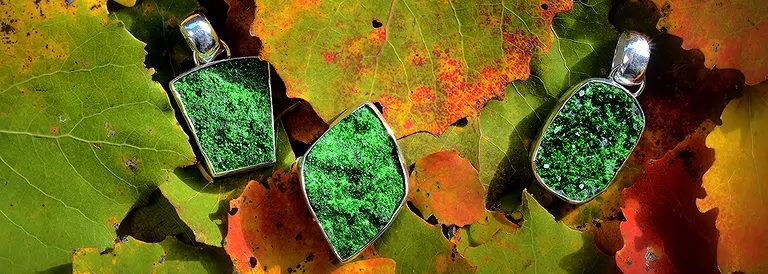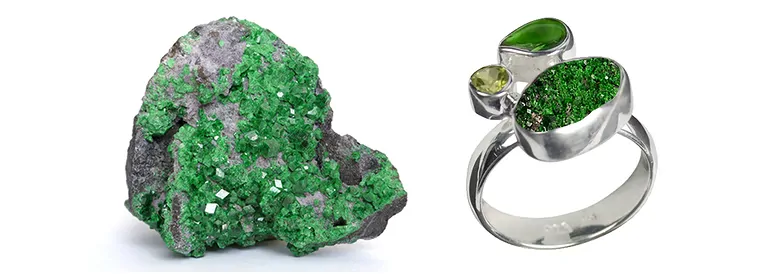
Uvarovite - Bearing, effect and application
Especially in difficult times, the Uvarovite can be a good companion: The glittering Uvarovite helps us to maintain an optimistic basic attitude to life and our intentions and not to lose curiosity about life. It helps to focus our gaze more on the beautiful sides of life, refreshes the senses and promotes creativity and optimism. Enthusiasm and drive for the implementation of our ideas are supported, individuality and independence as well.
Mineralogical profile of Uvarovite
Chemical Formula: Ca3Cr2[SiO4]3 + Fe,K,Mg,Mn,Na,Ni,Ti
Mineral class: Garnets are mineral-rich aluminum or iron minerals of the island silicates.
Origin: usually in metamorphic or hydrothermal contexts, in ultrabasic environments. Mandatory is also an increased chromium content.
Color: The color of the Uvarovite can vary from brown-green to dark emerald green, depending on the foreign admixtures and solid solution formations present. The more chromium present, the more intense the green of the mineral.
Gloss: Glass to fat luster; depending on foreign admixtures, purity and crystal defects.
Crystal system: cubic
Mohs hardness: 6.5 - 7.5
Cleavability: none
Breakage: conchoidal, splintery, brittle.
Localities, main countries of occurrence: The best known locality of Uvarovite are in the Perm region south of Saranovskoye and Teplaja Gora Ural, Russia); there are rare Uvarovite crystals with size up to eight millimeters. Other localities are in Finland, Ethiopia, Tasmania, Australia, China, Italy, Japan, Cuba, Canada; Nepal and the USA.
Appearance: numerous small crystals as "crystal lawn", rarely single crystals.
Availability: rare
Jewelry with Uvarovite at wholesale prices

Origin of the name Uvarovite
Uvarovite is a rare member of the garnet group. The discovery of the mineral Uvarovite happened rather accidentally, when in 1832 the Swiss-Russian mineralogist and chemist Germain Henri Hess (1802 - 1850) examined a stone from the mineralogical collection in St. Petersburg. This was marked with the name Dioptase, but Hess was suspicious and examined the stone more closely. The stone, labeled as "Dioptase of Bissersk" then proved to be a previously unknown, chromium-containing garnet. In honor of the Russian mineral collector and President of the Imperial Academy of Science Sergei Semyonovich Uvarov, the newly discovered mineral was named Uvarovite. A well-known synonym is due to the color-giving substance the name chrome garnet.
Historical facts about Uvarovite
The best Uvarovite crystals come from the deposit in Russia, in the Urals. From this deposit, they were used to make precious stones for the imperial court. Tsarina Catherine II (known as "Catherine the Great", 1729 - 1796) had a particular a particular fondness for green gems, such as garnets and emeralds. It is likely that specimens of Uvarovite and the rare demantoid were also in her possession. Both representatives of the garnet family, however, were not known at that time not known under these names.
Uvarovite jewelry and specimen at wholesale prices
Usage and application of Uvarovite
The emerald green Uvarovite represents individuality and independence. He promotes drive and enthusiasm to be able to implement with momentum their own ideas and plans, even in the time of waning light and the retreat of nature. Uvarovite with its strong green shades is a stone of the heart chakra. In astrology, the garnets are attributed to the signs Aries and Scorpio.
Uvarovite as a representative of the garnet group
Uvarovite belongs to the large group of garnets. It is true for all garnets that they were considered good helpers in crisis situations. In the Middle Ages, the garnet was called carbuncle and the legend tells that it glows in the dark, which is not literally, but in a figurative sense. What is meant is that the darkened soul is illuminated and in hopeless situations garnet brings hope and light - as, for example, a raw garnet crystal often looks very inconspicuous and only by Cut and polish unfolds its fire, the difficulties of life were considered a spiritual grinding process, through which only the character was refined.
In fact, the garnet was especially fashionable in times of crisis, for example, after the First and Second World Wars. In many families of our grandparents, necklaces, rings and earrings made of garnet were among the most popular pieces of jewelry.
